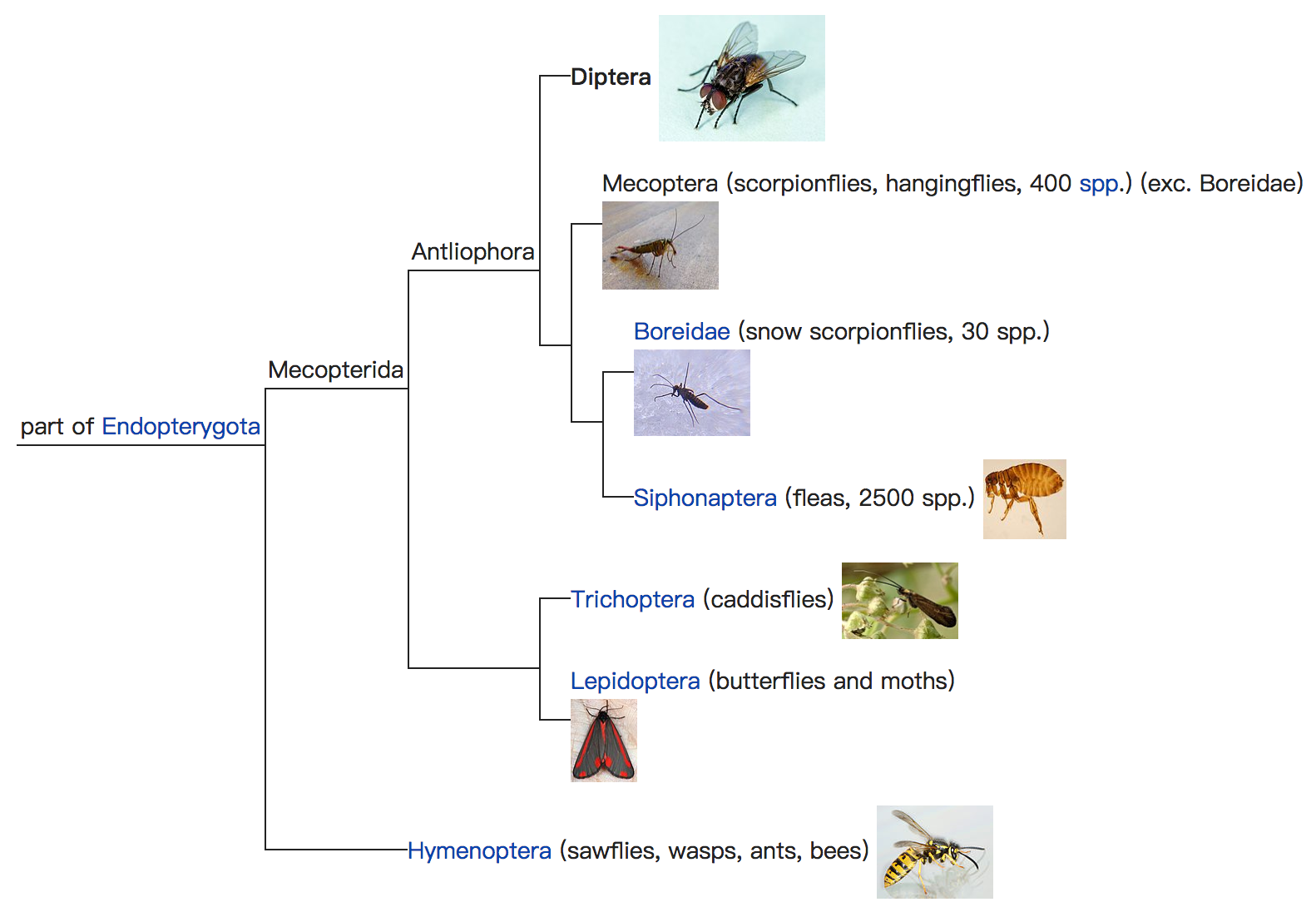True flies are insects of the order Diptera, the name being derived from the Greek δι- di- "two", and πτερόν pteron "wings". Insects of this order use only a single pair of wings to fly, the hindwings having evolved into advanced mechanosensory organs known as halteres, which act as high-speed sensors of rotational movement and allow dipterans to perform advanced aerobatics.[1] Diptera is a large order containing an estimated 1,000,000 species including horse-flies,[a] crane flies, hoverflies and others, although only about 125,000 species have been described.[4]
fly: 苍蝇
true flies: 真正的苍蝇,还是说这个true有啥特别含义
insect: 昆虫
Diptera: 双翅目昆虫
dipterans: 双翅目
order: 动物学中的一个术语
hindwings: 前后翅,后翅
mechanosensory: 机械感觉
halteres: not found
rotational: 旋转的,轮流的
aerobatics: 特技飞行
Flies have a mobile head, with a pair of large compound eyes, and mouthparts designed for piercing and sucking (mosquitoes, black flies and robber flies), or for lapping and sucking in the other groups. Their wing arrangement gives them great maneuverability in flight, and claws and pads on their feet enable them to cling to smooth surfaces. Flies undergo complete metamorphosis; the eggs are laid on the larval food-source and the larvae, which lack true limbs, develop in a protected environment, often inside their source of their food. The pupa is a tough capsule from which the adult emerges when ready to do so; flies mostly have short lives as adults.
mobile: 移动的,活动的
compound eyes: 复眼
mouthparts: 口器
pierce: 穿刺,砭
suck: 吮吸
lap: 舐,舔
maneuverability: 机动性
claws: 爪,爪子,钩
undergo: 经历,经受
metamorphosis: 变态
larval,larvae: 幼虫
lack: 缺乏,缺少,匮乏
limbs: 四肢,下肢,分支
pupa: 蛹
capsule: 胶囊
emerges: 出现,产生,出来
Diptera is one of the major insect orders and of considerable ecological and human importance. Flies are important pollinators, second only to the bees and their Hymenopteran relatives. Flies may have been among the evolutionarily earliest pollinators responsible for early plant pollination. Fruit flies are used as model organisms in research, but less benignly, mosquitoes are vectors for malaria, dengue, West Nile fever, yellow fever, encephalitis, and other infectious diseases; and houseflies, commensal with humans all over the world, spread food-borne illnesses. Flies can be annoyances especially in some parts of the world where they can occur in large numbers, buzzing and settling on the skin or eyes to bite or seek fluids. Larger flies such as tsetse flies and screwworms cause significant economic harm to cattle. Blowfly larvae, known as gentles, and other dipteran larvae, known more generally as maggots, are used as fishing bait and as food for carnivorous animals. They are also used in medicine in debridement to clean wounds.
ecological: 生态的
pollinators: 授粉,传粉,授粉者
Hymenopteran: 膜翅目,膜翅目昆虫
fruit flies: 果蝇
benignly: 良性,宽厚,和蔼
vectors: 载体
commensal: 共生的,共栖的
food-borne: 经由食物传播的
annoyances: 烦恼的,烦恼的事情
Taxonomy and phylogeny
taxonomy: 分类
phylogeny: 发展史
Relationships to other insects
Dipterans are endopterygotes, insects that undergo radical metamorphosis. They belong to the Mecopterida, alongside the Mecoptera, Siphonaptera, Lepidoptera and Trichoptera.[5][6] The possession of a single pair of wings distinguishes most true flies from other insects with "fly" in their names. However, some true flies such as Hippoboscidae(louse flies) have become secondarily wingless.[7]
radical: 激进的,基,部首,根号
The cladogram represents the current consensus view.[8]

to be continued ......